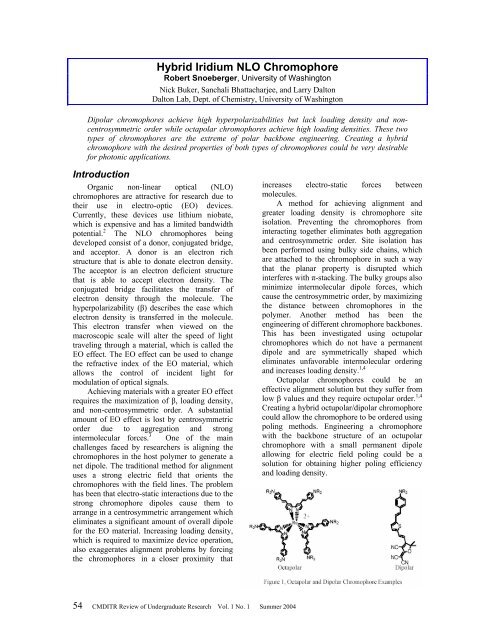CMDITR Review of Undergraduate Research - Pluto - University of ...
CMDITR Review of Undergraduate Research - Pluto - University of ...
CMDITR Review of Undergraduate Research - Pluto - University of ...
Create successful ePaper yourself
Turn your PDF publications into a flip-book with our unique Google optimized e-Paper software.
Hybrid Iridium NLO Chromophore<br />
Robert Snoeberger, <strong>University</strong> <strong>of</strong> Washington<br />
Nick Buker, Sanchali Bhattacharjee, and Larry Dalton<br />
Dalton Lab, Dept. <strong>of</strong> Chemistry, <strong>University</strong> <strong>of</strong> Washington<br />
Dipolar chromophores achieve high hyperpolarizabilities but lack loading density and noncentrosymmetric<br />
order while octapolar chromophores achieve high loading densities. These two<br />
types <strong>of</strong> chromophores are the extreme <strong>of</strong> polar backbone engineering. Creating a hybrid<br />
chromophore with the desired properties <strong>of</strong> both types <strong>of</strong> chromophores could be very desirable<br />
for photonic applications.<br />
Introduction<br />
Organic non-linear optical (NLO)<br />
chromophores are attractive for research due to<br />
their use in electro-optic (EO) devices.<br />
Currently, these devices use lithium niobate,<br />
which is expensive and has a limited bandwidth<br />
potential. 2 The NLO chromophores being<br />
developed consist <strong>of</strong> a donor, conjugated bridge,<br />
and acceptor. A donor is an electron rich<br />
structure that is able to donate electron density.<br />
The acceptor is an electron deficient structure<br />
that is able to accept electron density. The<br />
conjugated bridge facilitates the transfer <strong>of</strong><br />
electron density through the molecule. The<br />
hyperpolarizability (β) describes the ease which<br />
electron density is transferred in the molecule.<br />
This electron transfer when viewed on the<br />
macroscopic scale will alter the speed <strong>of</strong> light<br />
traveling through a material, which is called the<br />
EO effect. The EO effect can be used to change<br />
the refractive index <strong>of</strong> the EO material, which<br />
allows the control <strong>of</strong> incident light for<br />
modulation <strong>of</strong> optical signals.<br />
Achieving materials with a greater EO effect<br />
requires the maximization <strong>of</strong> β, loading density,<br />
and non-centrosymmetric order. A substantial<br />
amount <strong>of</strong> EO effect is lost by centrosymmetric<br />
order due to aggregation and strong<br />
intermolecular forces. 3 One <strong>of</strong> the main<br />
challenges faced by researchers is aligning the<br />
chromophores in the host polymer to generate a<br />
net dipole. The traditional method for alignment<br />
uses a strong electric field that orients the<br />
chromophores with the field lines. The problem<br />
has been that electro-static interactions due to the<br />
strong chromophore dipoles cause them to<br />
arrange in a centrosymmetric arrangement which<br />
eliminates a significant amount <strong>of</strong> overall dipole<br />
for the EO material. Increasing loading density,<br />
which is required to maximize device operation,<br />
also exaggerates alignment problems by forcing<br />
the chromophores in a closer proximity that<br />
increases electro-static forces between<br />
molecules.<br />
A method for achieving alignment and<br />
greater loading density is chromophore site<br />
isolation. Preventing the chromophores from<br />
interacting together eliminates both aggregation<br />
and centrosymmetric order. Site isolation has<br />
been performed using bulky side chains, which<br />
are attached to the chromophore in such a way<br />
that the planar property is disrupted which<br />
interferes with π-stacking. The bulky groups also<br />
minimize intermolecular dipole forces, which<br />
cause the centrosymmetric order, by maximizing<br />
the distance between chromophores in the<br />
polymer. Another method has been the<br />
engineering <strong>of</strong> different chromophore backbones.<br />
This has been investigated using octupolar<br />
chromophores which do not have a permanent<br />
dipole and are symmetrically shaped which<br />
eliminates unfavorable intermolecular ordering<br />
and increases loading density. 1,4<br />
Octupolar chromophores could be an<br />
effective alignment solution but they suffer from<br />
low β values and they require octupolar order. 1,4<br />
Creating a hybrid octupolar/dipolar chromophore<br />
could allow the chromophore to be ordered using<br />
poling methods. Engineering a chromophore<br />
with the backbone structure <strong>of</strong> an octupolar<br />
chromophore with a small permanent dipole<br />
allowing for electric field poling could be a<br />
solution for obtaining higher poling efficiency<br />
and loading density.<br />
54 <strong>CMDITR</strong> <strong>Review</strong> <strong>of</strong> <strong>Undergraduate</strong> <strong>Research</strong> Vol. 1 No. 1 Summer 2004




